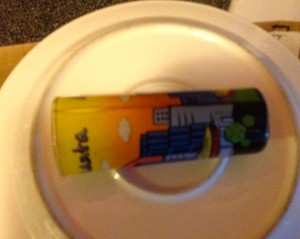
I’d gotten the idea from seeing them on Pinterest. I did do some picking through thrift stores to find odd bits of china, but also used some pieces I’d gathered over the years. It seemed like a nice way to carry out the decluttering mission, but preserve some of those memories. I augmented some pieces with glass or metallic spray paint and glued on glass pebbles, marbles, and other odd bits. The fixative for all of this is Marine Goop, which you can find on Amazon.
If I had more workspace, I might employ the Dremel in some of this, by drilling holes in things and then using a screw and bolt to hold the constructions together. However, the glue is marine fixative that is super strong and waterproof. I’m going over to Mom’s tomorrow to get some of the flowers set up and that will be the first test.
Tips for creating glass/china garden flowers:
- Glue in stages and let them dry completely. Gluing the shot glass (or bottle) on the back will probably be the last thing you do. I used plastic containers to hold the flowers upside while the shotglass set.
- Give yourself plenty of time. That glass paint is supposed to dry for four days before you set it by baking it. I may have shortened that a bit in my rush and it remains to be seen what the result is.
- Don’t be afraid to adorn. I glued on glass charms and pebbles, gold candy paper, pearl beads, and a cat toy.
- Keep it on the cheap by a) seeing what you have already in cupboards and crafting supply boxes that can be sued, b) checking when thrift stores have their china and glassware on sale, and c) looking for chipped items that are discounted further.
- Don’t just look at china and glassware. I used chipped Christmas ornaments, a ceramic garden pot spray-painted copper, and a metal serving plate. Next time I’m thrifting I’ll look for round mirrors as well. One great example I saw used old knives arranged like spikes around the outer edge.
The Pinterest versions suggested gluing bottles to the back, but that seemed very large to me given the size of the flowers. Instead I used tall shot glasses, which run fifty cents each at our local Goodwill. The mounts are lengths of rebar capped with a padded top made of terrycloth from a cut-up towel and duct tape.
As a writer, I think it’s important to be creative in other ways. I cook, I garden, and sometimes I make things. Usually I give those things away because otherwise I would drown in objects. The flowers were a fun way to exercise that urge to make, and somewhere down the line I’ll be doing flash stories to go with each one. In the meantime, I’ve written the titles for those already.
I’ll go through the individual ones in posts. Here’s the first.

I think this ornament is a reasonable example of preserving memories. The ice cream glass is part of a set acquired several decades ago. I have a poem about willow ware, so I like using it. The glass charms are part of a hanging ornament that I received several years ago, and I’ve had the marbles since high school.









